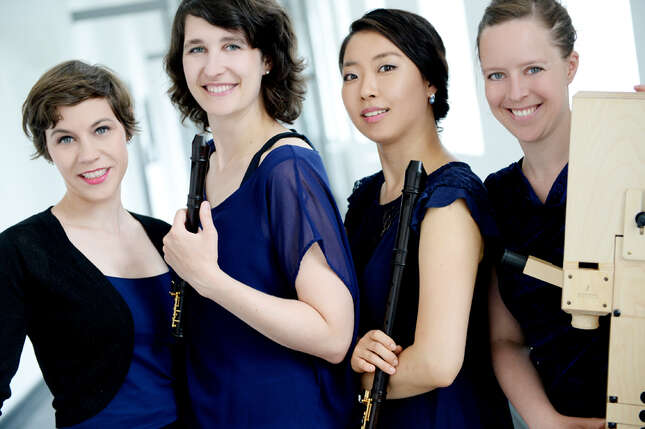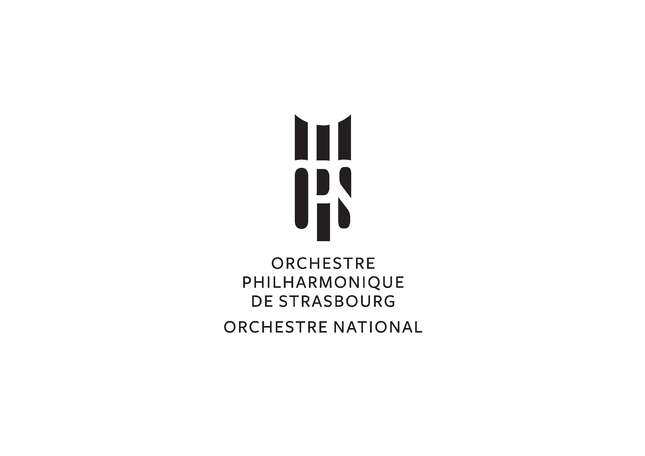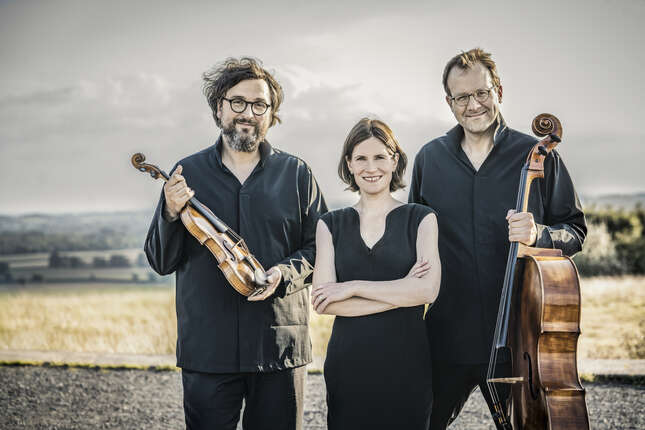
Ihre Suchergebnisse (9960 gefunden)


Ensemble orchestra Orchestre de la Suisse Romande

Ensemble orchestra Polish National Radio Symphony Orchestra (NOSPR)

Ensemble orchestra la festa musicale
la festa musicale
... is a baroque ensemble from northern Germany. Since it was founded in 2014, the young chamber orchestra has swiftly made a name for itself through its passion, stylistic accuracy and virtuosity. High motivation and the first-class artistic niveau of all its musicians are characteristic of the ensemble: they are charismatic representatives of a new generation of historical performance practice. la festa musciale has been a guest at the Schleswig-Holstein Music Festival, the Handel Festival Halle, the Festival Alte Musik Knechtsteden, the Lower Saxony Music Days and the Festival Alter Musik Regensburg. The artistic direction is in the hands of the ensemble's concert master, Anne Marie Harer.
The second CD of works by Haydn‘s predecessor Gregor Joseph Werner, conducted by Lajos Rovatkay, was released in autumn 2022. This was preceded by the album “Storie di Napoli“ (a baroque-musical city tour through mythical Naples with recorder player Barbara Heindlmeier and soprano Maria Ladurner) and an internationally acclaimed production with concertos by Francesco Venturini. There are also recordings of J. S. Bach‘s motets (with the Kammerchor Hannover) as well as church music by Bonifazio Graziani (with the Collegium Vocale Hannover), Diogenio Bigaglia and Antonio Lotti (with the Knabenchor Hannover). Concerts of la festa musicale have been recorded by Bavarian Radio (BR), Deutschlandfunk and North German Radio (NDR - Norddeutscher Rundfunk).
The ensemble has performed with internationally renowned soloists and conductors such as Jörg Breiding, Anna Dennis, Peter Kooij, Joanne Lunn, Hermann Max, Klaus Mertens, Alex Potter, Andreas Scholl, Jörg Straube and Zachary Wilder.
la festa musicale is committed to passing on its own unique enthusiasm for early music to diverse and inquisitive audiences. It is particularly interested in the creation of its own programmes and performance formats. Family and children's concerts such as “Locatelli or the Eavesdropping Magnifying Glass“, programmes narrated by the ensemble itself as well as music education projects in primary schools and refugee accommodation bring performers and listeners together: a festival of clapping, singing and dancing!
As one of 16 orchestras and ensembles, la festa musicale is part of the federal funding programme “Excellente Orchesterlandschaft Deutschland“ in 2023/2024. It is an official and institutionally sponsored partner of the UNESCO City of Music Hannover, Ensemble in Residence of the Hanoverian Markuskirche and cooperation partner of the Forum Agostino Steffani.
“la festa musicale is a young and very likeable baroque ensemble. [...] Rarely have I experienced this combination of immense passion, precision and spontaneity. My compliments!“ Andreas Scholl, Countertenor (2016)

Ensemble Recorder Consort Boreas Quartett Bremen
Since its inception in 2009, the Boreas Quartett Bremen has dedicated itself to the core repertoire of the recorder quartet: music from the renaissance and the modern era. The ensemble possesses a collection of over 40 recorders in various models and sizes, including a twelve-piece renaissance consort by Peter van der Poel, built after original instruments of the sixteenth century.
The Boreas Quartett Bremen has been invited by festivals including Musikfest Bremen, MDR-Musiksommer, Tage Alter Musik Saarbrücken, Boston Early Music Festival (USA), Music Before 1800 New York (USA), Musica Antica Urbino (Italy), Taiwan International Recorder Festival, Concentus Moraviae (Czech Republic), baroque muerz (Austria) and AMUZ Antwerp (Belgium). The four musicians have been praised in the press for their “tonal mastery”, their “lively, great expressiveness, outstanding tech-
nique, perfect intonation and incredible precision in their music-making”.
Jin-Ju Baek, Elisabeth Champollion, Julia Fritz and Luise Manske studied recorder from 2004 to 2009 with Han Tol at the Early Music department of the University of the Arts Bremen.
In 2014, the ensemble was accepted into Germany’s 59 th Federal Selection of Young Artists’ Concerts, and in 2012, the quartet won the Saarländischer Rundfunk’s Early Music Advancement Prize and the Audience Award. The musicians have also been able to gain the support of foundations for numerous projects, including the foundations “Laudate, Cantate”, Heinz Peter and Annelotte Koch, Waldemar Koch, Dr. Christiane
and Bernd Rogge and the Mariann Steegmann Foundation. From 2020 to 2023, the Boreas Quartett Bremen will be supported by the Bremen culture senator’s ensemble programme.

Ensemble orchestra Orchestre philharmonique de Strasbourg
Under the musical and artistic direction of Aziz Shokhakimov from this season, the Orchestre philharmonique de Strasbourg ranks as one of the major orchestras in France, with the label of “National Orchestra” being awarded in 1994. With 110 permanent musicians perpetuating its dual French/German tradition, the Orchestra is engaged in an ambitious project centred on symphonic music targeting all types of audiences and performs over 100 concerts every year. Its international renown is constantly enhanced by its dynamic audio-visual coverage.
The Orchestra boasts a vast repertoire from the 18th century to the present day for which internationally renowned conductors and soloists are invited, but it is also greatly attached to promoting a new generation of artists.
The Orchestra has also adopted an extensive audio-visual policy with a number of media partners, thereby ensuring visibility on a national and international scale.
The Orchestra contributes to Strasbourg’s outreach in France, performing regularly at the Philharmonie de Paris, and throughout Europe in the most prestigious concert halls.
With an impressive discography to its name, the Orchestra caused a sensation with its recording of two landmark opuses by Berlioz: Les Troyens and La Damnation de Faust, unanimously acclaimed by critics worldwide. The release of the CD BariTenor with Michael Spyres in September 21 has been widely acclaimed and awarded. Two recordings of opuses dedicated to Janáček and Prokofiev under the Warner label are still to be released this season.

Ensemble quintet ARUNDOSquintett
The international ARUNDOSquintett – Anna Saha (flute), Yoshihiko Shimo (oboe), Christine Stemmler (clarinet), Lisa Rogers (horn) and Yuka Maehrle (bassoon) has its artistic home in the federate state of North Rhine-Westphalia, which awarded the quintet a three-year ensemble grant in 2020. The debut CD Origin was supported by a grant from the Kunststiftung NRW and received enthusiastic reviews in the specialised press as well as from Deutschlandfunk, Deutschlandfunk Kultur and rbb Berlin. With Saga, the ensemble is now presenting its second CD release, again sponsored by the Kunststiftung NRW.
On stage, the ARUNDOSquintett has delighted audiences in numerous chamber music series, for example at the Kölner Philharmonie, the WDR Funkhaus Köln and Beethovenhaus Bonn, on tours to Spain, Italy, Denmark and Belgium, as well as at the Rheingau Musik Festival and Kempen Klassik.
Founded in 2013 at the Hochschule für Musik und Tanz Köln, the ARUNDOSquintett won prizes at the Antón García Abril 2014 and Castilla y León 2015 chamber music competitions, as well as a scholarship from the Werner Richard – Dr. Carl Dörken Foundation and the Best of NRW 2016 concert series. The ensemble qualified for participation in the ARD Music Competition 2014, Carl Nielsen International Music Competition 2015 and Osaka International Chamber Music Competition 2017.
Its extensive repertoire ranges from the classical composer Anton Reicha and arrangements from the romantic period to French and German wind chamber music of the twentieth century, as well as very recent compositions. In 2020, the ensemble announced a composition competition at German music colleges in order to inspire the next generation of composers for the wind quintet genre.
Broadening musical horizons is just as important to the ARUNDOSquintett as is varied and knowledgeable programme design spanning different epochs and styles – and, not least, dialogue with the audience, stimulated by their own personal concert introductions. The CD recordings bear witness to this passion for presenting the newer repertoire for wind quintet in first recordings and expanding it with commissioned compositions.

Ensemble piano trio Morgenstern Trio

Ensemble orchestra New Philharmonia Orchestra

Ensemble vocal ensemble Voktett Hannover
The VOKTETT HANNOVER was founded in 2012 by students of the Hanover University of Music, Drama and Media as a mixed and double-choir vocal ensemble and has since developed into one of the leading national a cappella formations. The eight singers perform a wide variety of programmes at renowned concert series and festivals throughout Germany. These include the Bachfest Leipzig, chor.com, the Kultursommer Nordhessen, Rheingau Musik Festival, Festspiele Mecklenburg-Vorpommern, MDR Musiksommer, Sommerliche Musiktage Hitzacker, Internationale A-cappella-Woche Hannover and the Stunde der Kirchenmusik Stuttgart.
The ensemble’s extensive a cappella repertoire ranges from the beginnings of polyphonic vocal music to commissions from contemporary composers. In joint concert programmes, the VOKTETT HANNOVER also performs together with other renowned ensembles, including the baroque ensembles L’Arpeggiata, la festa musicale, Concerto Ispirato and the vocal ensemble VOCES8. The ensemble has given several performances of Johann Sebastian Bach’s St John Passion in small vocal formation.
The VOKTETT HANNOVER won first prize of the Felix Mendelssohn Bartholdy University Competition in 2015 and of the German Choir Competition in 2018. The ensemble was awarded the German Record Critics’ Prize for the album Gregor Joseph Werner: Masses and Motets. Other CD releases were also met with critical acclaim and a number of concert recordings and further contributions have been aired by various public broadcasters in recent years.
VOKTETT HANNOVER has been closely associated with Hanover’s Markuskirche as its ensemble in residence for many years. Since 2024, the ensemble has received institutional funding from the city of Hanover (UNESCO City of Music).